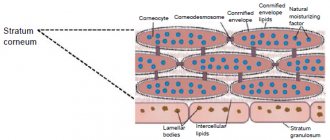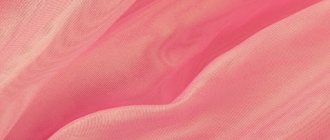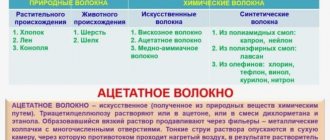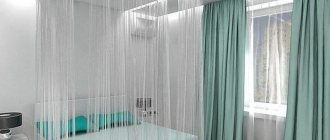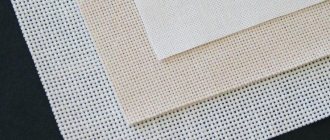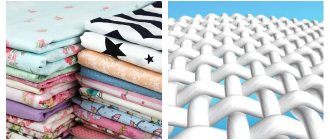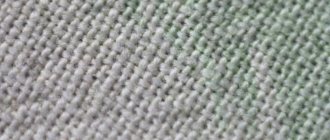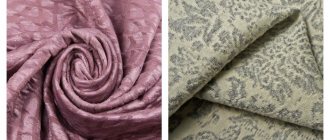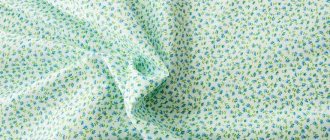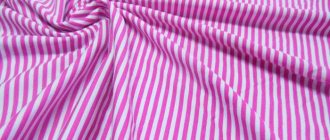To get a beautiful, even stitch on things, you need to take into account many factors. One of them is a competent choice of threads. If they do not correspond to the type of material or needle size, the stitches will be uneven, ugly, or missing completely.
Sometimes the thread simply breaks, which suggests a malfunction of the equipment, but more often the reason is the wrong choice. What factors should you pay attention to when selecting? What types are they presented in?
Types of threads and nuances of operation
Each sewing machine comes with instructions that indicate how to use a certain type of thread depending on the material. Sewing products are represented by the following types:
Cotton
A universal solution that goes well with handmade work, which is important both when sewing a new item and when restoring an old one.
They are in demand both among sewing masters and beginners. Cotton products are inexpensive and suitable for any material.
A universal solution is size 50, but if the fabric is too thin, tears and holes in the stitch area are likely.
With a high density of the material being processed, on the contrary, the strength may be too low, which can lead to ruptures.
Polyester
Synthetics ensure a beautiful, even stitch. Due to the smoothness of the fibers, there are no roughnesses in the stitch area that are characteristic of other materials. The threads are elastic and can withstand some tension without causing even minimal damage.
A modified solution is a polyester thread in a cotton sheath, combining the advantages of both options.
Reinforced
The special structure of the fibers ensures maximum elasticity and resistance to mechanical stress. Domestic marking is determined by the type of material.
LH - cotton-based thread, LL - flax, LS - wool. Thickness is also indicated; the higher the number, the thinner the product.
Nylon
They withstand contact with water, including long-term contact, and are characterized by fairly high rigidity, and therefore are used in the production of shoes, bags and other accessories subject to high loads. In clothing, nylon threads can be used for hidden stitches. The thread is formed from one fiber, or from several, the structure affects the strength.
Silk
Contrary to popular belief, it is permissible to use silk threads not only with fabrics made from similar raw materials or wool, but also with others. They are quite expensive, but are characterized by color fastness and do not fade with regular ironing or high-temperature washing.
The main point is to choose the correct size and focus on the structure of the material being sewn.
Special types of threads are used to decorate clothes and form unusual embroideries and patterns. Special threads with metallized fibers and impregnations with compounds capable of accumulating and emitting light are also suitable for these purposes.
What are sewing threads made of?
The first large group of threads are natural. They are made from environmentally friendly materials - cotton, silk, linen. More than 50% of the threads produced by the textile industry are made from cotton. This is the name of a shrubby plant of the malvaceae family, which can be annual or perennial. There are about fifty types of cotton, but only four are suitable for the production of threads: hairy (shaggy), Barbados, tree-like, grass-like.
Cotton is grown in fields specially designed for this purpose, harvested, and combed. This is how cotton fibers are obtained, the longest of which reach 6-7 cm. The cotton yarn obtained in this way is processed with special compounds and goes to the spinning shop. Here the fibers are twisted into long, even threads. But they are not yet usable. Sewing threads are made by twisting long fibers into 2-3 layers.
Silk threads are made from raw silk. The volume of production of these products in total production occupies no more than 1%. The principle of processing this raw material is in many ways similar to cotton processing. Another natural material from which sewing threads are made is flax.
The second group of threads is synthetic. This material is obtained from chemical fibers: polyamide or polyester. Artificial silk is made from polyester, metallized aluminum fiber, and nylon. Synthetic products can be twisted from left to right (S-twist) and from right to left (Z-twist). In addition, reinforced, complex, textured and staple fibers are distinguished.
Sewing threads can be combined, consisting of natural and artificial fibers. Currently, pure cotton, linen or silk products are rarely used. For sewing the vast majority of products, a thread made of polyester and covered with cotton is used. The synthetic core of this material provides stretch resistance, while the outer natural layer makes it smoother.
Marking features
To understand the marking, you need to consider that threads can be natural, mixed, or synthetic.
For example, the classification of natural threads is as follows:
- Cotton (cotton). In their pure form, they are rarely used, as they lack strength and wear resistance. Their area of application is sewing clothes that must meet the most stringent requirements for hygiene and safety, for example, baby undershirts, diapers;
- Silk (c), viscose (c) - mainly used for decorative purposes, in needlework, embroidery;
- Linen (marking varies depending on the manufacturer and country of manufacture) - used when working with heavy, high-density fabrics, for example, tarpaulin for backpacks and travel bags.
Synthetic and combined threads are presented in the following categories:
- Reinforced (LH, LL, LS) - the most durable and universal. The thickness is different, varies from 36 to 80, so you can choose a solution for sewing clothes from thin fabric, and for making shoes from thick leather, specialized textiles;
- Polyester threads, including staple threads (L, LSh). The products withstand contact with moisture, are elastic and very durable. Staple threads are used for sewing knitwear, thick polyester threads are used for shoes, bags, leather accessories;
- Polyester textured (PT). The most common solution for sewing knitwear, they are cheap, elastic and durable;
- Polyamide (K). They are used infrequently, can withstand prolonged contact with moisture, but, unfortunately, are afraid of temperature fluctuations.
Foreign brands actively use metric numbering, in which the first number indicates the number of meters of thread in its gram. A number separated by a fraction indicates addition. Also, foreign brands fix the direction of twist: s – left, z – right.
The number of folds affects the quality; the more, the better.
How to choose threads for sewing
How not to get lost in the world of threads and choose the right ones? Let's talk about how sewing threads are selected. They vary in thickness and fibrous composition. The choice depends on the material with which the thread will interact.
Cotton threads (Cotton)
Universal threads, used for sewing any range, and especially for the production of children's clothing. These threads come in matte and glossy. The threads are treated with various compounds to improve their properties. Then they are called mercerized. By number, cotton threads are 10,20,30,40,50,60,80,100. Number 100 is used for very thin fabrics, respectively, number 30 is used for denser ones.
Synthetic threads are made from lavsan and polyamide fibers in pure form or in various combinations.
According to their production, synthetic threads are: Complex.
Externally, they are very reminiscent of silk threads and are highly durable. Therefore, they are often used for sewing buttonholes. Complex threads are made from nylon (60K) or lavsan (60L). Nylon is more durable, but lavsan has higher heat resistance. That is, when working with an iron, the temperature should be 160-165 ° C for nylon threads and up to 240 ° C for lavsan threads. The numbers for filament threads are 22, 33, 55, 90. For example, 22 or 33L are considered the thinnest and are used when working with thin fabrics, and 55 - 90 when working with thick ones.
Textured.
This type of thread is used for overcasting parts and when working with knitted fabrics. Such threads provide good elongation and strength. Numbers 18LT, 24LT, 37LT and so on. The higher the number, the thicker the threads.
Reinforced.
These threads consist of a combination of different fibers. For example, lavsan and cotton (LH). Such threads are much stronger, more elastic, and more wear-resistant. They are used in the clothing and footwear industries. Designated 36ЛХ - for thin and medium fabrics and knitted fabrics, 44ЛХ, 65ЛХ - for thicker ones. If the threads are polyester, then next to the number there are the letters LL, for example 35LL.
Monofilament.
Made from nylon or nylon. These threads are very elastic, durable and abrasion resistant. And their most important advantage is that monofilaments can acquire the color of the material thanks to the optical preparations with which they are processed. These threads are used to create invisible stitching, blind hems, as well as for weaving beaded jewelry and sewing on rhinestones.
Threads for decorative stitching.
Many products use finishing stitching as decoration. The threads for it can be matched to match or contrasting. And in order for the finishing stitch to stand out in relief on the product, you need to use thicker, twisted threads.
The author of the article is Alena Izhak, teacher of the lingerie sewing course at the GRASSER school in St. Petersburg.
Principles for selecting threads based on shade, shine, and fabric quality
The listed indicators are of greatest importance during selection. In addition, the fibers must be uniform; this indicator can be assessed by examining the threads on fabric of a contrasting tone. The main quality parameter is a smooth structure with no compactions or knots. Strength can be determined by tension; at its average value, ruptures are unacceptable.
You can choose the thickness of the thread according to the type of product being manufactured and the characteristics of the fabric:
Children's clothes, knitwear, products based on natural cotton. The best option is standard size 40 cotton threads.
Light items made of chiffon, tulle. The best solution is a 70-80 size reel.
Thick fabric used for tailoring suits is processed with 50-70 threads.
Thin products made from dressed wool, satin, and synthetics look great when processed with threads with a thickness of 40 to 70.
For heavy, dense fabrics (such as tarpaulin), artificial, natural leather, strong threads of 30-40 are used.
Silk threads are the most versatile, therefore, there are essentially no restrictions on compatible fabrics.
Properties
Cotton threads are very popular among knitters. Available in a wide range of textures and colors. You can knit any products from it: tablecloth, jacket, panama hat.
The main common properties of all types of cotton fibers are: hygiene and resistance to various detergents. Because of their positive qualities, they are used for knitting things for children. Their properties are similar to viscose.
Cotton items are hygienic
Important! It is worth noting that if organic yarn with 100% cotton content is used, then the fabric from it is not very elastic.
Distinctive features:
- The fabric made from it is durable, soft and pleasant to the body. However, it is not as durable as silk.
- This material is easy to wear.
- It is heat resistant. It is able to absorb water well and at the same time it does not seem wet.
- Hypoallergenic. High resistance to alkalis, but is destroyed by acids.
- Yarn is a heavy material. It is not resistant to the influence of bacteria and microorganisms. If the threads are left in damp conditions for a long time, they begin to mold and rot.
Cotton products absorb moisture well
- The natural look can only be painted in faded colors.
- The mercerized look can be painted in bright and rich colors. It may also be a little shiny. This look looks much better. It is more durable, but has less elongation. This is a big advantage, since regular fabric is not durable. This type also shrinks more after drying.
- The mercerized look has threads that are softer and more delicate to the touch.
- After finishing, the cotton fabric becomes crease-resistant and non-shrinking.
You might be interested in this: Features of Virginia wool, description of Lana cashmere fabric
If the threads have undergone a double mercerization process, then all its positive qualities are doubled. Mercerized types of fabrics are more expensive than regular ones.
The mercerized type has the best properties
Cotton fibers hold dirt better than other types of yarn. This is due to the fact that the fibers are loose and lumpy. Dirt holds better on these types of surfaces. If the item can be boiled, then it can be washed in a washing machine. The water temperature should be 90 degrees. If the linen is colored, then the water temperature should be 40 degrees. Drying in a machine is only possible if there is a special symbol on the product label.
These products can only be ironed if they are damp. The iron temperature must be set to that recommended on the product label. The ironing temperature depends on how the threads are processed: mercerization or finishing.
Cotton products are easy to care for
Classification by finishing features
According to the type of finish, the following materials can be distinguished:
- Matte (feature: complete lack of shine, maximum light absorption);
- Glossy (characterized by shine, making the item more unusual);
- Harsh (made from a material that cannot be cleaned or bleached);
- Standard plain, colored, white or black threads;
- “Smoking” type threads. They are needed to create a gathered effect on the fabric. When treated with heat, they form shrinkage, the stitching tightens, taking the base material with it. The relief features are determined by the type of seam and the structure of the material;
- Threads with special processing that gives them certain properties. For example, this category includes materials treated with a reflective substance or a composition that ensures the ability to withstand open fire.
Quality checking
To purchase a truly high-quality thread, you need to be guided by several points:
It is better to focus on products from trusted brands that are respected by experienced seamstresses.
Unnamed Chinese goods are cheap, however, the markings on the spool do not always correspond to reality; there is a high probability that, for example, the reinforced threads will contain cheaper, low-quality fibers that are not strong enough for sewing some things.
You need to unwind the spool a little and inspect the thread. A high-quality product is smooth to the touch, its thickness is uniform along the entire length, there are no lumps or excessively thin areas. If this condition is not met, then tears will form in thin places, and folds of fabric will form in thick places.
Unfortunately, defects cannot always be seen with the naked eye, and in this case even minimal deviations are important. To avoid mistakes, you need to conduct an inspection using a magnifying glass.
You should also check the uniformity of the shade. If the color is the same along the entire length, this means that the manufacturer strictly adheres to production technology.
Any deviations are clearly visible against a contrasting background. For example, the quality of black thread can be easily checked against the background of contrasting white fabric.
The thread needs to be tightened a little. Any thread has a small reserve of elasticity if it is of high quality, regardless of the material. The rupture will follow only after some tension has been felt.
Expert opinion
Maria Anishchenko
Experienced seamstress, total experience 18 years
Practice shows that threads made from natural raw materials, be it cotton or linen, need to be checked most carefully. Synthetics are cheaper, easier to produce, and do not require the manufacturer to use expensive machines and equipment. Low-quality synthetic threads are very rare.
Quite often there are old threads on the farm that are already 2-3 decades old. Thrifty housewives are trying to use them in business, but this is a wrong decision.
The thread seems to be a very simple product, however, if the temperature and other storage conditions are not observed, the material is destroyed and the structure loses its uniformity.
This affects not only the quality of sewing, but can also damage the mechanisms of modern sewing machines. Even a small knot will lead to jamming; you will have to stop work and carefully remove the material from the work area.
Correspondence table for material, needle numbers and thread markings
| Material | Type of thread | Needle number |
| Lightweight fabrics. Finished cotton fabrics of minimal thickness, artificial and natural silks, synthetics, knitwear | Cotton threads thickness from 80 to 100, polyester - from 60 to 80, nylon - from 80 to 100 | 9-11 with thread thickness from 70 to 80 |
| Medium weight fabrics. Cotton fabric, satin, canvas, wool, which has undergone appropriate processing. | Cotton threads thickness from 50 to 80, polyester - 50, nylon - 50-80 | 11-14 |
| Heavy fabrics. High-density wool, specialized reinforced tarpaulin, aimed at making bags, tourist clothing, protective suits, fabric for sewing curtains, thick jeans. | Cotton threads – 40-50, polyester – 50, nylon – 50-60 | 14-16 |
| Elastic materials, e.g. double jersey, special fabrics for sports overalls. | Polyester – 50-80, nylon 50 | 11-14. It is better to use special needles designed specifically for working with synthetic fabrics. |
